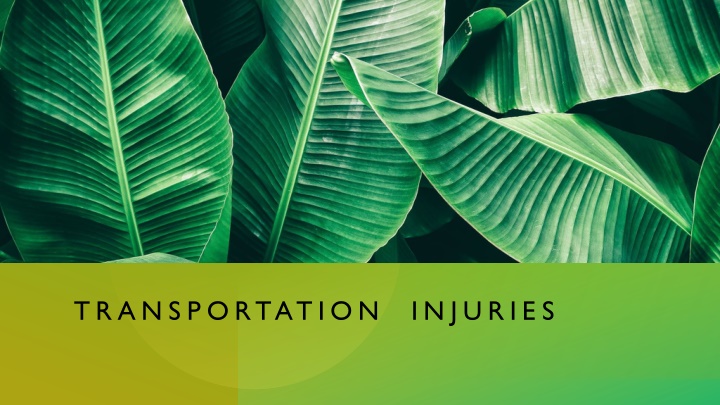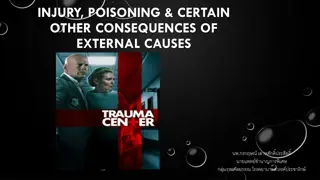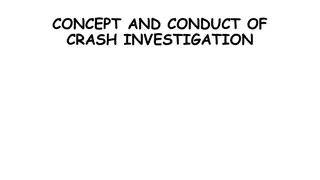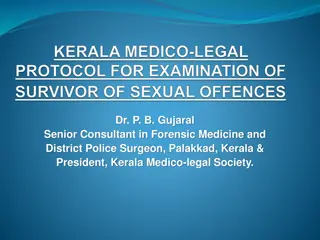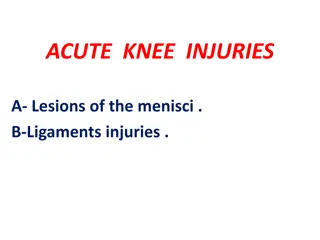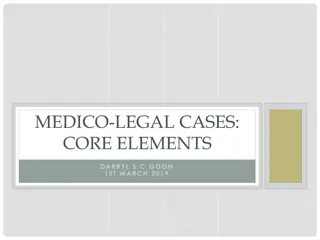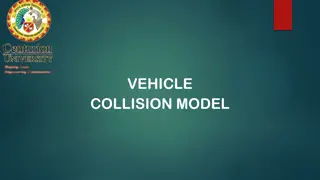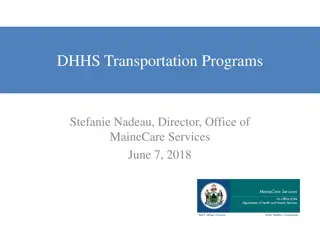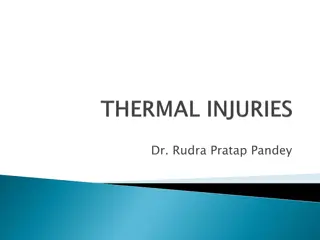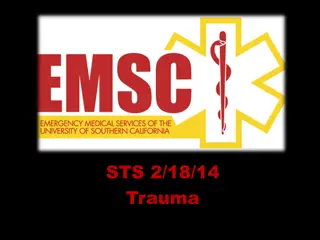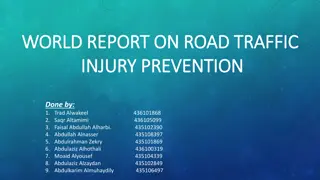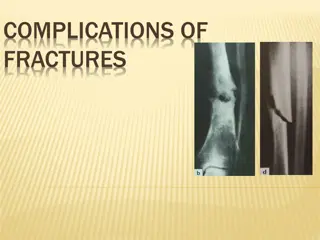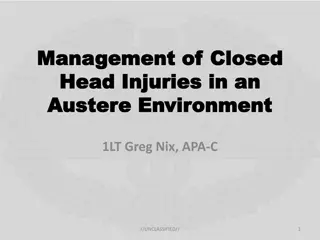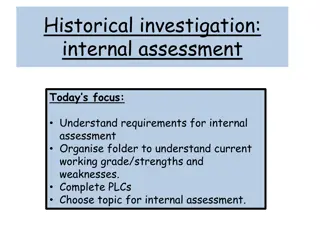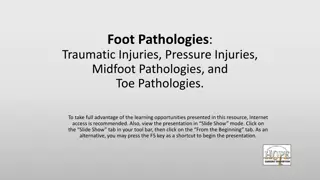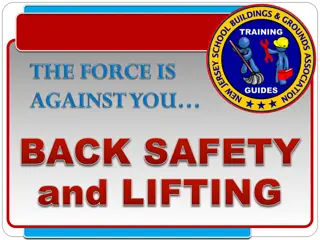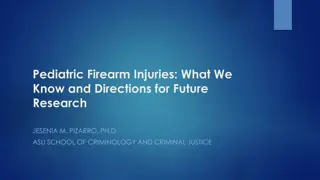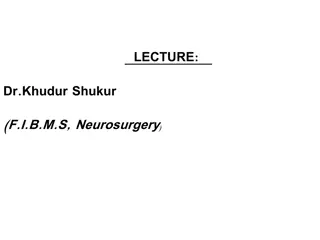Transportation Injuries and Medico-Legal Investigation
Purpose of medico-legal investigation in transportation injuries includes determining cause of death, confirming injury-related deaths, detecting extent of injuries, identifying contributing factors, aiding insurance claims, accident reconstruction, and vehicle identification in hit-and-run cases. Types of accidents such as auto-pedestrian, auto-auto, auto-cycle, and auto-train are discussed, along with injuries sustained by pedestrians and occupants. The process of accident reconstruction involves examining victims and vehicles. Additionally, the text touches on possible questions related to external injuries, autopsies, occurrence of certain injuries, and the types of death under law.
Download Presentation

Please find below an Image/Link to download the presentation.
The content on the website is provided AS IS for your information and personal use only. It may not be sold, licensed, or shared on other websites without obtaining consent from the author.If you encounter any issues during the download, it is possible that the publisher has removed the file from their server.
You are allowed to download the files provided on this website for personal or commercial use, subject to the condition that they are used lawfully. All files are the property of their respective owners.
The content on the website is provided AS IS for your information and personal use only. It may not be sold, licensed, or shared on other websites without obtaining consent from the author.
E N D
Presentation Transcript
T R A N S P O RTAT I O N I N J U R I E S
PURPOSES OF MEDICO-LEGAL INVESTIGATION IN TRANSPORTATION INJURIES 1.Determine the cause of death 2.Confirm that death was caused by injuries suffered from accident 3.Detect the extent of injuries 4.Detect any disease or factor that could have precipitated or contributed to the death or accident 5.For third party insurance. 6.For accident reconstruction. 7.For identification of the car in hit and run case
TYPES OF ACCIDENT Auto-pedestrian accident ( car vs man ) Auto-auto accident ( car vs car ) Auto-cycle accident Auto-train accident TYPES OF INJURIES Man can be injured in 2 ways as pedestrian (outside the car) (pedestrian injury) as occupant (during in the car) ( auto-auto ) (vehicle occupant injury)
Auto-pedestrian accident Type of pedestrian injuries - 1. Primary impact injuries 2. Secondary impact injuries 3. Secondary injuries( Tertiary impact) 4. Run over injuries (head, chest, abdomen, and limb)
Auto-auto accident ( car vs car ) Type of occupant injuries 1. Driver injury 2. The front seat passenger 3. The back seat passengers
Accident reconstruction 1. Examination of victim 2. Examination of the car
Possible questions Name the type of external injuries the person sustained (eg. picture of facial inj or chest injury driver inj of occupant inj in auto auto accident, primary impact injury of legs-> pedestrian inj in auto-ped acci) Aims & objectives of doing autopsy in TA List the pedestrian /occupant injuries in auto-pedestrian/ auto-auto accident Medico-legal importance of P/ S or driver injury Possible cause of death regarding to the given statement Explain 2/3 important points in medico-legal investigation for accident reconstruction
THANATHOLOGY & SUDDEN NATURAL DEATH Types of death by law Natural death Unnatural death Accidental - Homicidal - Suicidal
ESTIMATION OF POST-MORTEM INTERVAL: The interval between time of death and the time of examination of a body is known as Post Mortem interval(Definition PMI). This is important : To know when the crime was committed It gives the police a starting point for their enquiries, and allows them to deal more effectively with the information available It might enable to exclude some suspects and the search for the likely culprits started earlier, and Also to check on a suspect s statements
parameters available for estimation of time since death) (BMI) (1) Cooling of the body (2) Hypostatic staining (3) Rigor mortis (4) Progress of decomposition, adipocere and mummification. (5) Entomology of the cadaver: (6) Gastrointestinal and urinary tract: The amount of stomach contents and the extent of their digestion may be helpful to estimate the time of death. The stomach empties in 3 to 4 hours. Accordingly if undigested food is found in the stomach at post-mortem examination the deceased must have died within 3 to 4 hours of his last meal.
Whether the bladder is empty or not, in the case of an individual having been murdered in bed at night, one can state that the individual had lived for some hours after going to bed if the bladder was found full of urine since people usually empty their bladder before going to bed. (7) CSF: Examination of CSF obtained by cisternal puncture, which should be free from blood, is useful in adults above 15 years of age. (8) Vitreous humour: There is increase in the K concentration and decrease in Na during the first 85 hrs after death. The levels of glucose and pyruvic acid decrease and lactic acid increase. (9)Scene markers: though unscientific, is often accurate in some circumstances, esp; in case of badly decomposed body. The date of mail or newspapers, degree of coagulation of milk, state of food on a table etc. may be valuable. If the watch has stopped, the hour at which it has stopped should be noted. In drowning, the watch commonly stops shortly after immersion.
Aims and objectives of doing post-mortem examination in sudden deaths 1. to uncover secret homicides 2. to check and prevent certain public health hazards 3. to enable widow, orphans or dependents to receive death benefits to which they are entitled 4. to avoid unwarranted suspicion or prosecution of innocent persons 5. to prevent false claims against insurers
CLASSIFICATION OF SUDDEN DEATHS (A)cardiac causes (B) respiratory causes (C) disease of the CNS (D) diseases of gastrointestinal system (E) diseases of urogenital system (F) miscellaneous
Possible questions Definition of death & types What is PMI , importance of PMI (points)parameters available for estimation of time since death (Estimation of post-mortem interval) Definition of SUD Objectives of autopsy in SUD Important findings & given COD Disease & trauma relation
